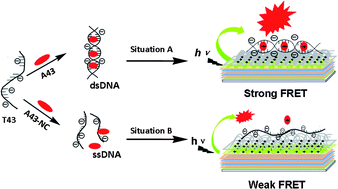Optically amplified DNA detection on self-assembled solid films using conjugated polyelectrolytes†
Abstract
A new label-free heterogeneous DNA detection method was developed using the fluorescent conjugated polyelectrolyte poly[9,9′-bis(6′′-(N,N,N-trimethylammonium)-hexyl)fluorene-2,7-ylenevinylene-co-alt-1,4-phenylene dibromide] (PFV). In this assay, Layer-by-Layer (LbL) assembly was used to form a polyelectrolyte multilayer thin film on a substrate, and enhance the adsorption ability and stability of PFV. A cationic poly-(allylamine hydrochloride) (PAH) buffer layer was deposited to increase deposition of DNA. DNA detection was studied using a platform with the double-stranded DNA (dsDNA) intercalator ethidium bromide (EB). The thickness of the PAH layer was controlled by pH to obtain an optimum distance between PFV and EB for efficient fluorescence resonance energy transfer (FRET). Because of the different interactions of dsDNA and single-stranded DNA (ssDNA) with EB, DNA hybridization was selectively detected by monitoring the FRET efficiency.


 Please wait while we load your content...
Please wait while we load your content...